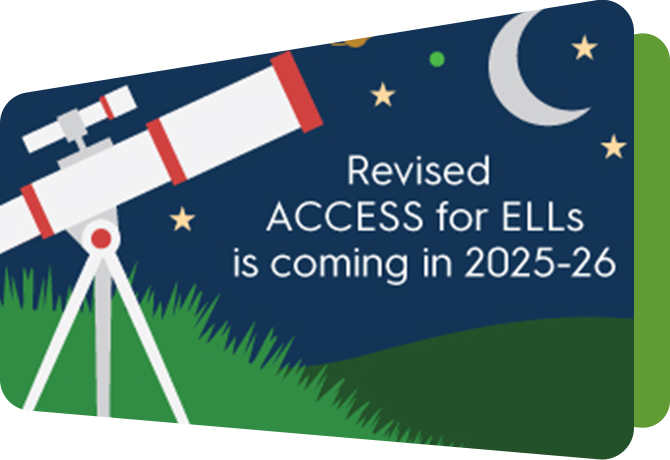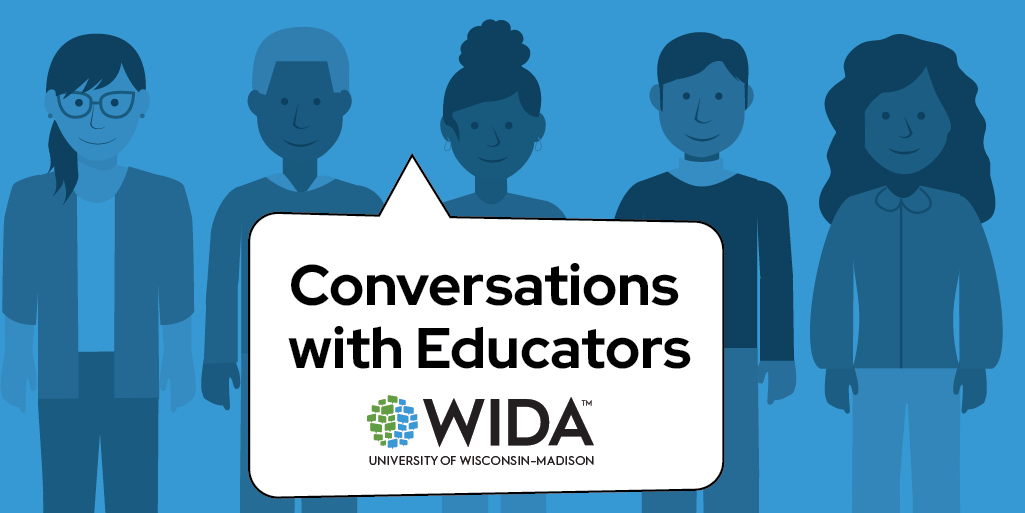WIDA ACCESS in 2025-26
For the last few years, we’ve been revising Kindergarten ACCESS for ELLs (Kindergarten ACCESS) and ACCESS for ELLs (ACCESS) so that they incorporate the WIDA ELD Standards Framework, 2020 Edition. Up next, we will revise WIDA Screener so that it incorporates the 2020 Edition. We will release a revised WIDA Screener in 2028.
WIDA Fact! ACCESS is a standards-referenced test. This means that student performance is compared to the WIDA ELD Standards Framework. Any student can achieve any score, and students are not ranked against each other or against the expected performance of monolingual English speakers.
Top Takeaways
- We removed “for ELLs” from the ACCESS name. The new names are WIDA ACCESS for Kindergarten and WIDA ACCESS.
- We completely redesigned Kindergarten ACCESS and incorporated new test content that reflects the input of many experienced educators.
- We made all the changes to ACCESS (grades 1-12) behind the scenes, so that the test administration experience is the same this school year as it was last school year.
- We will release ACCESS score reports on time – on track with your regular reporting timeline.
- We will hold a standard setting event in July 2026 to ensure that student scores still give an accurate picture of a student’s English language development.
A Special WIDA Thank You!
To everyone who participated in ACCESS Paper and Kindergarten ACCESS test development events, we couldn’t have done it without you! Here is a recap of our event participation by the numbers:
- 279,858 students
- 25,915 educators
- 35 states
Thank you to the nearly 20 teachers of the visually impaired (TVIs) who participated in test development work to create the Kindergarten ACCESS Test Administrator Script for Students with Low Vision. Work included
- Reviewing pre-pilot test materials with experts
- Reviewing pilot test materials with 10 TVIs across eight states
- Observing educators and students in Maryland and Wisconsin
Communications Toolkit
Help spread the word! Use the Communications Toolkit: WIDA ACCESS in 2025-2026 to share details about ACCESS in the 2025-2026 school year with your colleagues. Use the WIDA ACCESS in 2025-2026 PowerPoint slides in your presentations about ACCESS.

Kindergarten ACCESS
Find out what to expect with Kindergarten ACCESS in the 2025-2026 school year by exploring the following topics.
- Changes to the Assessment
If you’re familiar with Kindergarten ACCESS, you’ll notice these changes on the redesigned assessment:
- Fewer test materials to manage (no more activity board and fewer cards!)
- All four domains connect to a single new storyline
- Each language domain is administered once, with no starting or skipping rules
- New task types that reflect everyday classroom practices
- A separate score sheet to mark student scores for Listening and Speaking, Writing and Reading
- Revised scoring protocols and rubrics for Speaking and Writing tasks
- Training and Certification
Before administering Kindergarten ACCESS this school year, all test administrators must complete the redesigned WIDA ACCESS for Kindergarten: Administration and Scoring training course in the WIDA Secure Portal and pass the certification quiz. The training course will be available on September 29.
- Low Vision Accommodation
The new Low Vision Script (LV) accommodation is for Kindergarten ACCESS only. Here are some key features:
- This accommodation is intended for students with low vision who may need additional support during the administration of Kindergarten ACCESS.
- The Test Administrator Script for Students with Low Vision Accommodation gives test administrators additional scripting, specialized graphics and picture descriptions to support students with low vision.
- This accommodation may be used in combination with the Large Print materials or the standard size test materials, with or without additional magnification.
- To order the Test Administrator Script for Students with Low Vision Accommodation, LEAs will contact DRC Customer Service during their additional materials ordering window (this is the same process educators use to order the Human Reader Accommodation Script).
Find more information on the Low Vision Script (LV) accommodation in the
- Accessibility and Accommodations Manual
- WIDA ACCESS for Kindergarten: Administration and Scoring training course (available on September 29)
- WIDA ACCESS Test Administrator Manual (WIDA Secure Portal login required)
- WIDA ACCESS for Kindergarten for New Test Administrators Assessment Webinar on November 11, 2025
- Scoring Rubrics
Kindergarten ACCESS has been redesigned and incorporates the 2020 Edition. We now have new rubrics for scoring the Speaking and Writing (available September 29):
- Kindergarten Scoring Rubric for Speaking
- Kindergarten Scoring Rubric for Writing
The Scoring Rubric for Writing is located in the score sheet, where it can be easily referenced during administration and scoring. The Scoring Rubric for Speaking is included in the test materials as a reference. Test Administrators will continue to rely on the “Expect” boxes to score the Speaking domain in real time during test administration.
Kindergarten Scoring Rubric for Speaking
- Score points range from 0-6 (on the existing rubric it ranged from level 1-5).
- The Proficiency Level Descriptors are presented in easy-to-read dot points and not separated by the dimensions of language like they are on the existing rubric.
- There is a scoring notes and glossary section.
Kindergarten Scoring Rubric for Writing
- Score points still range from 0-6.
- The Proficiency Level Descriptors are presented in easy-to-read dot points and not separated by the dimensions of language like they are on the existing rubric.
- The examples and definitions now live in the scoring notes and glossary section instead of the rubric itself.
ACCESS Online and Paper
Find out what to expect with ACCESS in the 2025-2026 school year by exploring the following topics.
- Behind-the-Scenes Changes to the Assessment
We made all the changes to ACCESS behind the scenes, so that the test administration experience remains the same this school year. Here are some important details to keep in mind:
- Standard 1, which focuses on social and instructional language, is now incorporated throughout the test. Previously, Standard 1 was only in initial tasks or on tasks targeting lower proficiency levels.
- We’ve increased the number of possible score points for P1 tasks on the Tier A Speaking test by targeting the end of proficiency level 1. This gives students more opportunities to show what they can do.
- We have new scoring rubrics that replace the existing scoring scales for ACCESS.
Learn more about these changes in the Video Resources section below.
- Training Courses
Since ACCESS will use the new Speaking Scoring Rubric and WIDA Screener and ACCESS Braille will continue to use the Speaking Scoring Scale, you may have to complete different speaking scoring training courses this year:
Available July 1
- Speaking for Grades 1-5: Scoring WIDA Screener and ACCESS Braille
- Speaking for Grades 6-12: Scoring WIDA Screener and ACCESS Braille
Available September 1
- Speaking for Grades 1-5: Scoring ACCESS Paper
- Speaking for Grades 6-12: Scoring ACCESS Paper
Note: If you are administering both ACCESS Paper and WIDA Screener, or ACCESS Paper and ACCESS Braille, you may have to certify on separate courses in 2025-2026. Refer to your Member/State page this summer and fall for your state’s certification requirements.
- Scoring Rubrics
Now that ACCESS incorporates the 2020 Edition, we have new tools for scoring the Speaking and Writing domains (available September 1):
- WIDA Speaking Scoring Rubric Grades 1–12
- WIDA Writing Scoring Rubric Grades 1–12
DRC will use these new rubrics to hand score ACCESS Writing tests and ACCESS Online Speaking tests. Test administrators will use the WIDA Speaking Scoring Rubric Grades 1–12 to score ACCESS Paper Speaking. Test administrators will use the existing WIDA Speaking Scoring Scale Grades 1-12 to score ACCESS Braille.
Learn more about the process for developing the Writing Scoring Rubric in a 2024 Technical Report.
Pro tip: The best places to find appropriate scoring tools are in each assessment training course. Find all assessment training courses in the WIDA Secure Portal.
- ACCESS Scores (Grades K-12)
As part of our work to revise ACCESS (grades K-12), we need to ensure that student scores still give an accurate picture of a student’s English language development. This process happens during a standard setting event after the first annual administration of the revised assessments. In this case, the ACCESS standard setting event is scheduled for July 2026.
Important! Because of standard setting, you’ll need to approach your ACCESS score reports in 2026 with a bit of care.
As you prepare for ACCESS score reports in 2026, know that
- You will get score reports on your regular reporting timeline.
- You can use 2025-2026 ACCESS scores to make decisions about students for the 2026-2027 school year – either to exit students or decide on classroom placement.
- You should treat 2025-2026 ACCESS scale scores as a new baseline to measure growth against (you can't compare scale scores from previous years).
- You should use 2025-2026 ACCESS proficiency level scores with caution prior to the ACCESS Standard Setting 2026 event as they will reflect the old proficiency level cut scores.
Pro tip: Learn more about “proficiency level cut scores” and standard setting events in the news article about the Alternate ACCESS standard setting that took place in 2024.
In 2025-2026, you will need to track student growth differently. We recommend that you
- Gather additional classroom evidence throughout the year to help keep track of student growth and skill level.
- Use classroom assessments or other interim measures to get an idea of your students’ proficiency levels at the start, middle and end of the school year.
- Gather data from your students’ content teachers to track progress in specific subject areas.
- Connect with your students’ families to get a sense of how their language development is progressing at home.
ACCESS Standard Setting 2026
What is standard setting?
Anytime an organization significantly revises an assessment, like we’re doing with ACCESS, they must conduct a standard setting study. Standard setting is when a group of select, trained educators determine proficiency level scores and set cut scores for an assessment. Cut scores describe the level of student performance needed to meet the expectations of each proficiency level. For example, what scale score does a student need to receive a proficiency level of 2 or 3 at their grade level? Cut scores also help states determine the appropriate level a student must achieve on ACCESS to be considered proficient in English.
Standard setting must be conducted after the first annual administration of a revised assessment.
Who attends the standard setting event?
Standard setting panelists are English language and content teachers, as well as school and district administrators from across the WIDA Consortium. They are experts who work with multilingual learners and are familiar with ACCESS. SEA representatives from around the WIDA Consortium and WIDA's Technical Advisory Committee (TAC) are present to oversee the process, and data experts will be there to analyze data. Staff from WIDA and the Center for Applied Linguistics (CAL) host and facilitate the event.
Video Resources
Watch Revising ACCESS: The Impact of the Standards Framework, 2020 Edition (5 minutes) to learn about
- How ACCESS connects to the WIDA English Language Development Standards
- Key elements of the WIDA ELD Standards Framework, 2020 Edition
WIDA tip: This video gives a solid intro to ACCESS and the 2020 Edition. Share it with content area educators or anyone who needs a refresher on what ACCESS is and how it connects to the ELD Standards Framework.
Want to get all this information in written format? Read the Behind the scenes of WIDA ACCESS news article.
Watch Revising ACCESS: Emphasizing Standard 1 in the Listening and Reading Tests (4 minutes) to learn about
- Standard 1 and how it fits in the WIDA ELD Standards Framework
- How Standard 1 will affect the structure of Listening and Reading test items
Watch Revising ACCESS: Updates to the Speaking and Writing Tests (4 minutes) to learn about
- The Online Speaking test and P1 tasks
- The redesigned Writing Scoring Rubric
WIDA Language Charts
 The WIDA Language Charts are a new resource that can help you understand and communicate the expectations of the revised ACCESS for ELLs (WIDA ACCESS).
The WIDA Language Charts are a new resource that can help you understand and communicate the expectations of the revised ACCESS for ELLs (WIDA ACCESS).
The charts connect WIDA ACCESS to the WIDA English Language Development Standards Framework and make the Proficiency Level Descriptors clearer, more actionable and directly connected to classroom instruction.
The new Language Charts are a resource for all educators, even those without specialized language backgrounds. Learn more about the charts in the How to use our new language charts right now news article.
Using the Charts
Use the Language Charts to
- Get familiar with the revised expectations of WIDA ACCESS and WIDA ACCESS for Kindergarten
- Collaborate with content area colleagues
- Plan curriculum, instruction and classroom assessment
- Trace student growth in language development from unit to unit
Note: Beginning with WIDA ACCESS scores in the 2026-2027 WIDA testing year, you can also use the Language Charts to interpret and communicate about ACCESS scores.
New resources alert!
- Check out the brand-new WIDA Snapshot, Plan Curriculum, Instruction and Classroom Assessment With the WIDA Language Charts.
- Read the Experts answer WIDA Language Charts questions news article to get more information on how the charts relate to WIDA ACCESS and end of unit classroom assessment.
Language Charts
The charts are available in two formats:
- Use the pdf version of the WIDA Language Charts to review content anytime, print the charts or share the charts with colleagues.
- Use the Excel version of the WIDA Language Charts to easily copy and paste information into your own spreadsheet tools, create personalized charts or customize the charts for individual or small groups.
Related Resources
- Language Charts Informational Slides: Introduce colleagues to the WIDA Language Charts by using the Meet the WIDA Language Charts informational PowerPoint slides.
- Language Charts Facilitator Toolkit: Make the WIDA Language Charts the next discussion topic of your professional learning community! Pair the WIDA Language Charts Facilitator PowerPoint slides with the WIDA Language Charts Participant Handout. Since this slide deck takes an in-depth approach to using the Language Charts, plan at least 60-90 minutes for your collaborative group meeting. Note: Facilitators should be very familiar with the WIDA ELD Standards Framework, 2020 Edition.



